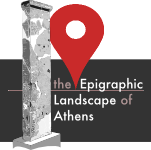Updates #4: Athenian state decrees between II and I cent. BCE
by Stefano Tropea
Between the II and the I cent. BCE, in the Greek world shaped by the Romans after 168 and 146 BCE, the epigraphical landscape of Athens appears to undergo an evolution that paralleled the redefinition of political relationships both outside and inside the polis. If on one side the Athenian institutions still dedicated great attention to juridical and religious issues, it was again on the honours to local individuals and groups that they concentrate their energies in the attempt to provide the…


